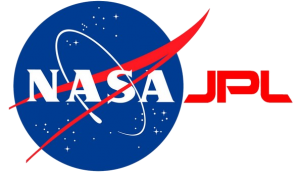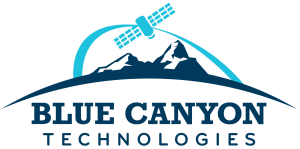-
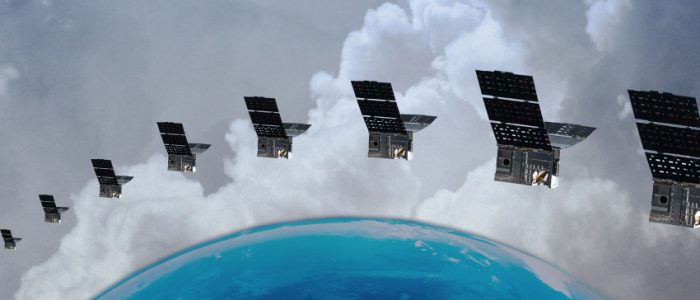 The TEMPEST mission concept deploys a closely-spaced train of CubeSats that carry identical low-mass, low-power millimeter-wave radiometers with full heritage from TEMPEST-D. The TEMPEST satellite train samples rapid changes in convection and the surrounding water vapor by observing every 3-4 minutes for up to 30 minutes. Image courtesy of NASA JPL.
The TEMPEST mission concept deploys a closely-spaced train of CubeSats that carry identical low-mass, low-power millimeter-wave radiometers with full heritage from TEMPEST-D. The TEMPEST satellite train samples rapid changes in convection and the surrounding water vapor by observing every 3-4 minutes for up to 30 minutes. Image courtesy of NASA JPL. -
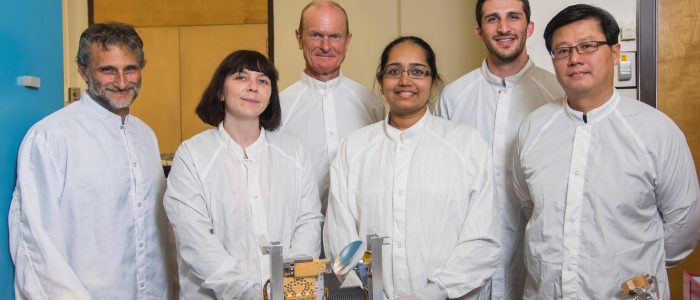 Todd Gaier, Heather Lim, Alan Tanner, Sharmila Padmanabhan, Rudi Bendig and Boon Lim (left to right) in the laboratory with the Temporal Experiment for Storms and Tropical Systems – Demonstration (TEMPEST-D) instrument at the NASA/Caltech Jet Propulsion Laboratory in Pasadena, CA. Image courtesy of NASA.
Todd Gaier, Heather Lim, Alan Tanner, Sharmila Padmanabhan, Rudi Bendig and Boon Lim (left to right) in the laboratory with the Temporal Experiment for Storms and Tropical Systems – Demonstration (TEMPEST-D) instrument at the NASA/Caltech Jet Propulsion Laboratory in Pasadena, CA. Image courtesy of NASA. -
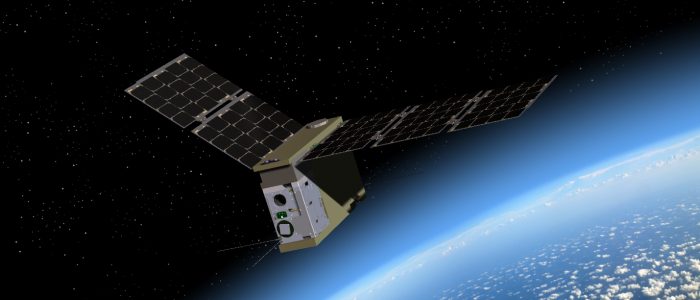 Artist's conception of TEMPEST-D satellite on orbit. Image courtesy of Blue Canyon Technologies.
Artist's conception of TEMPEST-D satellite on orbit. Image courtesy of Blue Canyon Technologies. -
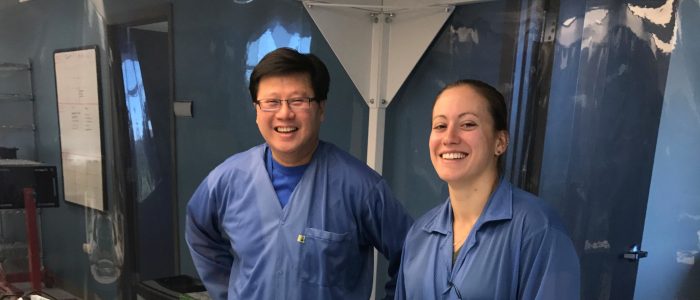 Boon Lim of NASA Jet Propulsion Laboratory and Natali Vannoy of Blue Canyon Technologies preparing to integrate the Temporal Experiment for Storms and Tropical Systems – Demonstration (TEMPEST-D) instrument into the spacecraft at Blue Canyon Technologies in Boulder, CO. Image courtesy of Blue Canyon Technologies.
Boon Lim of NASA Jet Propulsion Laboratory and Natali Vannoy of Blue Canyon Technologies preparing to integrate the Temporal Experiment for Storms and Tropical Systems – Demonstration (TEMPEST-D) instrument into the spacecraft at Blue Canyon Technologies in Boulder, CO. Image courtesy of Blue Canyon Technologies. -
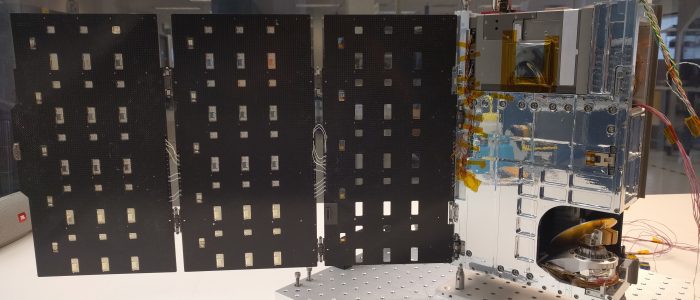 The Temporal Experiment for Storms and Tropical Systems – Demonstration (TEMPEST-D) satellite at Blue Canyon Technologies in Boulder, CO. Image courtesy of Blue Canyon Technologies.
The Temporal Experiment for Storms and Tropical Systems – Demonstration (TEMPEST-D) satellite at Blue Canyon Technologies in Boulder, CO. Image courtesy of Blue Canyon Technologies. -
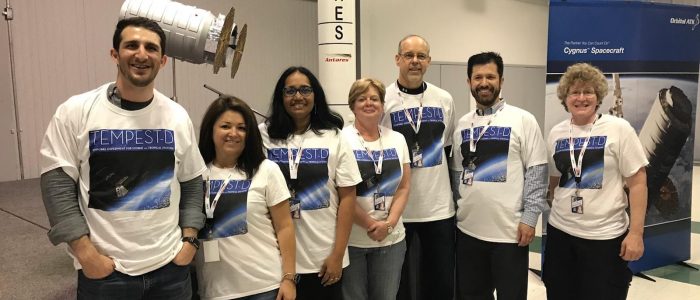 TEMPEST-D Team Members at the launch of Orbital ATK's 9th commercial resupply mission from NASA Wallops to the ISS on 5/21/18. From left to right: Rudi Bendig (JPL), Mary Soria (JPL), Sharmila Padmanabhan (JPL), Ann Batchelor (CSU), Bob Bauer (NASA ESTO Prog. Mgr), Steven Reising (CSU), Cate Heneghan (JPL).
TEMPEST-D Team Members at the launch of Orbital ATK's 9th commercial resupply mission from NASA Wallops to the ISS on 5/21/18. From left to right: Rudi Bendig (JPL), Mary Soria (JPL), Sharmila Padmanabhan (JPL), Ann Batchelor (CSU), Bob Bauer (NASA ESTO Prog. Mgr), Steven Reising (CSU), Cate Heneghan (JPL). -
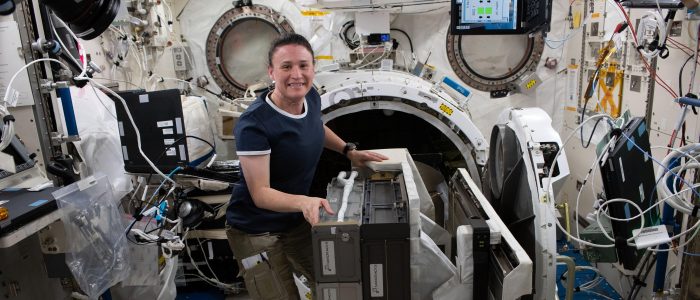 Expedition 56 Flight Engineer Serena Auñón-Chancellor installs the NanoRacks Cubesat Deployer-14 (NRCSD-14) on the Multipurpose Experiment Platform inside the Japanese Kibo laboratory module. The NRCSD-14 was then placed in the Kibo airlock and moved outside of the space station to deploy a variety of cubesats into Earth orbit. Image courtesy of NASA.
Expedition 56 Flight Engineer Serena Auñón-Chancellor installs the NanoRacks Cubesat Deployer-14 (NRCSD-14) on the Multipurpose Experiment Platform inside the Japanese Kibo laboratory module. The NRCSD-14 was then placed in the Kibo airlock and moved outside of the space station to deploy a variety of cubesats into Earth orbit. Image courtesy of NASA.
News
Related Links
Contact Info
TEMPEST Principal Investigator
Professor Steven C. Reising
Phone: 970-491-2228
E-mail: Steven.Reising@Colostate.edu
More News
- TEMPEST-D deorbits after successfully validating advanced remote-sensing instruments (June 22, 2021)
- CSU Research Magazine: "TEMPEST-D provides storm coverage" Magazine Cover and p. 15 (FALL 2019)
- NASA JPL: "An Inside Look at Hurricane Dorian from a Mini Satellite" (September 4, 2019)
- NASA JPL: "NASA's Multiple Views of Hurricane Dorian from Space" (August 29, 2019)
- Small, nimble CSU satellite has surpassed a year in space (July 29, 2019)
- NASA Science Mission Directorate Technology Highlights, "Big Weather Data from a Tiny CubeSat" pp. 35-36 (2018)
- New Small Satellite Peers Inside Hurricane Florence (Sept 20, 2018)
- Weather-monitoring and tech demo CubeSats deployed in orbit (July 21, 2018)
- CubeSats: Tiny Payloads, Huge Benefits for Space Research (June 19, 2018)
- Small Packages to Test Big Space Technology Advances (May 17, 2018)
- TEMPEST-D to Demonstrate Low-Cost Satellite Concept (May 2018)
- JPL CubeSat Clean Room: A Factory For Small Spacecraft (Dec 3, 2015)
Temporal Experiment for Storms and Tropical Systems (TEMPEST) deploys a closely-spaced train of 6U CubeSats carrying identical low-mass, low-power millimeter-wave radiometers. The TEMPEST train samples rapid changes in convection and the surrounding water vapor by observing every three to four minutes for up to 25-30 minutes. The millimeter-wave radiometers on TEMPEST provide soundings of mid-tropospheric water vapor to improve understanding of its role in the growth and organization of convection in various large-scale environments. The TEMPEST instrument observes at five millimeter-wave frequencies from 89 to 182 GHz. By rapidly sampling the life cycle of convection, TEMPEST fills a critical observational gap and complements existing and future satellite missions.

